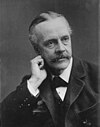| Alice Blanche BalfourFRES | |
|---|---|
| Born | (1850-10-20)20 October 1850 Whittingehame House, East Lothian, Scotland |
| Died | 12 June 1936(1936-06-12) (aged 85) Whittingehame House, East Lothian, Scotland |
| Parent(s) | James Maitland Balfour Lady Blanche Gascoyne-Cecil |
| Scientific career | |
| Fields | Entomology, genetics |
Alice Blanche Balfour FRES (20 October 1850 – 12 June 1936) was a Scottish entomologist, naturalist, scientific illustrator and one of the earliest pioneers in the science of genetics. Her extensive collection of Scottish moths is now in the care of National Museums Scotland.
Life
Balfour was born on 20 October 1850 at Whittingehame House in East Lothian, the daughter of Lady Blanche Gascoyne-Cecil (1825–1872) and James Maitland Balfour. She lived much of her adult life in London with her brother Arthur Balfour, 1st Earl of Balfour who was Prime Minister of the United Kingdom from 1902 to 1905. Her brother Francis Maitland Balfour was elected a Fellow of the Royal Society at the age of 27 for his work on embryology.
She developed a lifelong interest in entomology and later developed an interest in genetics and in particular the way that the patterns in zebra skins were inherited. She had a lengthy correspondence with James Cossar Ewart Professor of Zoology at University of Edinburgh who himself had a professional interest in the development of the horse. The correspondence relates to the possibility of cross-breeding zebra with horses to reduce the impact of tsetse fly on horses in Africa.
In 1895 she published the book Twelve Hundred miles in a Waggon which describes a trip taken by herself, H. W. Fitzwilliam, Albert Grey and his wife, and Albert Grey's cousin George Grey.
She was elected a Fellow of the Royal Entomological Society of London on 7 June 1916.
Balfour died on 12 June 1936 at Wittingehame House.
In 1936, her collection of over 10,000 moths, along with her catalogues and notebooks, was donated to National Museums Scotland. It is being used today, to study how the distribution of moths in Scotland have changed over time.
Alice's contributions to entomology were celebrated during Women's History month 2023, in an article in The Scotsman magazine.
References
- ^ Opitz, Donald L. (October 2004). ""Behind folding shutters in Whittingehame House": Alice Blanche Balfour (1850–1936) and amateur natural history". Archives of Natural History. 31 (2): 330–348. doi:10.3366/anh.2004.31.2.330. ISSN 0260-9541.
- ^ "Museum Moths". National Museums Scotland Blog. 5 June 2019. Retrieved 3 November 2023.
- 1851 England Wales and Scotland Census for Whittingham House, Whittingehame, Dunbar, Haddingtonshire (East Lothian), Scotland (subscription required)
- "Death at 86 of Miss Alice Balfour". The Telegraph. London. 13 June 1936. Retrieved 22 August 2014. (subscription required)
- ^ "MISS ALICE BLANCHE BALFOUR. (1936, Jun 13)". The Scotsman. 13 June 1936. p. 14.
- 1911 Census of England Wales and Scotland - St Martins in the Field, London
- "New Strides, Old Stripes: Zebras and the tsetse fly". ed.ac.uk. 5 May 2014.
- "Yesterday's New Books". The Standard. 12 December 1895.
- Balfour, Alice Blanche (1896). Twelve Hundred Miles in a Waggon (2nd ed.). London: Edward Arnold.
- Whiffin, Ashleigh (12 March 2023). "'Alice Balfour' In: Herstory - women who changed the world". The Scotsman magazine. pp. 4–5. Retrieved 3 November 2023.
| Arthur James Balfour, 1st Earl of Balfour | ||
|---|---|---|
| Premiership |  | |
| General elections | ||
| Constituencies | ||
| Family |
| |
| Career | ||
| In popular culture |
| |
| See also | ||
This article about a biologist from Scotland is a stub. You can help Misplaced Pages by expanding it. |
- 1850 births
- 1936 deaths
- Balfour family (Whittingehame)
- Scottish geneticists
- Scottish entomologists
- British women geneticists
- Women entomologists
- 19th-century Scottish women scientists
- 20th-century British women scientists
- People from Dunbar
- Scottish travel writers
- British women travel writers
- Fellows of the Royal Entomological Society
- Scottish biologist stubs